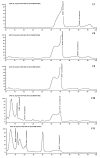Sechium edule (Jacq.) Swartz, a New Cultivar with Antiproliferative Potential in a Human Cervical Cancer HeLa Cell Line
- PMID: 28757593
- PMCID: PMC5579592
- DOI: 10.3390/nu9080798
Sechium edule (Jacq.) Swartz, a New Cultivar with Antiproliferative Potential in a Human Cervical Cancer HeLa Cell Line
Abstract
The Sechium edule Perla Negra cultivar is a recently-obtained biological material whose progenitors are S. edule var. nigrum minor and S. edule var. amarus silvestrys, the latter of which has been reported to have antiproliferative activity against the HeLa P-388 and L-929 cancer cell lines. The present study aimed to determine if the methanolic extract of the fruit of the Perla Negra cultivar had the same biological activity. The methanolic extract was phytochemically characterized by thin layer chromatography (TLC) and column chromatography (CC), identifying the terpenes and flavonoids. The compounds identified via high performance liquid chromatography (HPLC) were Cucurbitacins B, D, E, and I for the terpene fractions, and Rutin, Phlorizidin, Myricetin, Quercetin, Naringenin, Phloretin, Apigenin, and Galangin for the flavonoid fractions). Biological activity was evaluated with different concentrations of the methanolic extract in the HeLa cell line and normal lymphocytes. The methanolic extract inhibited the proliferation of HeLa cells (IC50 1.85 µg·mL-1), but the lymphocytes were affected by the extract (IC50 30.04 µg·mL-1). Some fractions, and the pool of all of them, showed inhibition higher than 80% at a concentration of 2.11 µg·mL-1. Therefore, the biological effect shown by the methanolic extract of the Perla Negra has some specificity in inhibiting tumor cells and not normal cells; an unusual feature among molecules investigated as potential biomedical agents.
Keywords: Perla Negra; biological activity; cancer; chayote.
Conflict of interest statement
The authors declare that they have no conflicts of interest. The funding sponsors did not have any role in the design of the study; collection, analyses, or interpretation of data; writing of the manuscript; or decision to publish the results.
Figures






Similar articles
-
Chemical analyses and in vitro and in vivo toxicity of fruit methanol extract of Sechium edule var. nigrum spinosum.Pharm Biol. 2017 Dec;55(1):1638-1645. doi: 10.1080/13880209.2017.1316746. Pharm Biol. 2017. PMID: 28427292 Free PMC article.
-
Potent anti-cervical cancer activity: synergistic effects of Thai medicinal plants in recipe N040 selected from the MANOSROI III database.J Ethnopharmacol. 2013 Aug 26;149(1):288-96. doi: 10.1016/j.jep.2013.06.037. Epub 2013 Jul 2. J Ethnopharmacol. 2013. PMID: 23831080
-
New insight into phenolic composition of chayote (Sechium edule (Jacq.) Sw.).Food Chem. 2019 Oct 15;295:514-519. doi: 10.1016/j.foodchem.2019.05.146. Epub 2019 May 22. Food Chem. 2019. PMID: 31174790
-
Chayote (Sechium edule): A review of nutritional composition, bioactivities and potential applications.Food Chem. 2019 Mar 1;275:557-568. doi: 10.1016/j.foodchem.2018.09.146. Epub 2018 Sep 25. Food Chem. 2019. PMID: 30724233 Review.
-
Squirting Cucumber, Ecballium elaterium (L.) A. Ritch: An Update of Its Chemical and Pharmacological Profile.Molecules. 2024 Sep 14;29(18):4377. doi: 10.3390/molecules29184377. Molecules. 2024. PMID: 39339372 Free PMC article. Review.
Cited by
-
Micropropagation of Chayote (Sechium edule L.) var. virens levis in RITA®.Methods Mol Biol. 2024;2759:97-104. doi: 10.1007/978-1-0716-3654-1_10. Methods Mol Biol. 2024. PMID: 38285143
-
Effect of Sechium edule var. nigrum spinosum (Chayote) on Oxidative Stress and Pro-Inflammatory Markers in Older Adults with Metabolic Syndrome: An Exploratory Study.Antioxidants (Basel). 2019 May 27;8(5):146. doi: 10.3390/antiox8050146. Antioxidants (Basel). 2019. PMID: 31137783 Free PMC article.
-
Galangin: A Promising Flavonoid for the Treatment of Rheumatoid Arthritis-Mechanisms, Evidence, and Therapeutic Potential.Pharmaceuticals (Basel). 2024 Jul 19;17(7):963. doi: 10.3390/ph17070963. Pharmaceuticals (Basel). 2024. PMID: 39065811 Free PMC article. Review.
-
Genotypes of Sechium spp. as a Source of Natural Products with Biological Activity.Life (Basel). 2024 Dec 27;15(1):15. doi: 10.3390/life15010015. Life (Basel). 2024. PMID: 39859955 Free PMC article.
-
Natural Bioactive Compounds of Sechium spp. for Therapeutic and Nutraceutical Supplements.Front Plant Sci. 2021 Dec 21;12:772389. doi: 10.3389/fpls.2021.772389. eCollection 2021. Front Plant Sci. 2021. PMID: 35756862 Free PMC article.
References
-
- Flores M.E. The chayote, Sechium edule Swartz (Cucurbitaceae) [(accessed on 30 March 2017)];Rev. Biol. Trop. 1989 37:1–54. Available online: https://www.ncbi.nlm.nih.gov/pubmed/2690200. - PubMed
-
- Rzedowski J. Aspectos de las plantas ornamentales mexicanas. Chapingo Serie Hortic. 1995;1:5–7.
-
- Lira-Saade R. Promoting the Conservation and Use of Underutilized and Neglected Crops. 8. Institute of Plant Genetics and Crop Plant Research; Gatersleben/International Plant Genetic Resources Institute; Rome, Italy: 1996. [(accessed on 29 March 2017)]. Chayote. Sechium edule (Jacq.) Sw. p. 57. Available online: http://pdf.usaid.gov/pdf_docs/Pnach876.pdf.
-
- Avendaño-Arrazate C.H., Cadena-Iñiguez J., Arevalo-Galarza M.L.C., Campos-Rojas E., Cisneros-Solano V.M., Aguirre-Medina J.F. Las Variedades del Chayote Mexicano, Recurso Ancestral con Potencial de Comercialización. Grupo Interdisciplinario de Investigación en Sechium edule en México AC (GISeM); Estado de México, Mexico: 2010. [(accessed on 29 March 2017)]. Available online: http://snics.mx/sinarefi/biblioteca/Las%20variedades%20dek%20chayote%20m....
-
- Cambar P.J., Portillo P., Tabora F.E., de Pineda L., Tovar O., Casco J., Alvarado C., Díaz G., Casco B., Cantillo L. Estudio preliminar sobre las acciones farmacológicas de Sechium edule. [(accessed on 29 March 2017)];Rev. Méd. Hondur. 1980 48:97–99. Available online: http://www.bvs.hn/RMH/pdf/1980/pdf/Vol48-4-1980-3.pdf.
MeSH terms
Substances
LinkOut - more resources
Full Text Sources
Other Literature Sources

